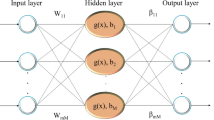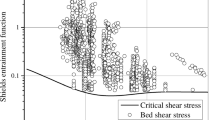Abstract
The minimum velocity required to prevent sediment deposition in open channels is examined in this study. The parameters affecting transport are first determined and then categorized into different dimensionless groups, including “movement,” “transport,” “sediment,” “transport mode,” and “flow resistance.” Six different models are presented to identify the effect of each of these parameters. The feed-forward neural network (FFNN) is used to predict the densimetric Froude number (Fr) and the extreme learning machine (ELM) algorithm is utilized to train it. The results of this algorithm are compared with back propagation (BP), genetic programming (GP) and existing sediment transport equations. The results indicate that FFNN-ELM produced better results than FNN-BP, GP and existing sediment transport methods in both training (RMSE = 0.26 and MARE = 0.052) and testing (RMSE = 0.121 and MARE = 0.023). Moreover, the performance of FFNN-ELM is examined for different pipe diameters.





Similar content being viewed by others
Abbreviations
- A :
-
Cross-sectional area of the flow
- a i :
-
Learning factors of the hidden nodes (Eq. 6)
- B j :
-
Bias of the jth neuron of the hidden layer (Eq. 8)
- b i :
-
Learning factors of the hidden nodes (Eq. 6)
- C V :
-
Volumetric sediment concentration
- d :
-
Median diameter of particle size
- D :
-
Pipe diameter
- D gr :
-
Dimensionless particle number
- Fr :
-
Densimetric Froude number
- G(a i , b i , x):
-
Is the output of the ith hidden node for input x (Eq. 6)
- g :
-
Gravitational acceleration
- g(.):
-
Nonlinear activation piecewise continuous function (Eq. 8)
- H ik :
-
Activation matrix of the jth neuron of the hidden layer for the kth training case (Eq. 8)
- H’:
-
is the Moore-Penrose inverse of Matrix H (Eq. 14)
- R :
-
Hydraulic radius
- s :
-
Specific gravity of sediment (=ρ s /ρ)
- S 0 :
-
Pipe slope
- T :
-
Axis representing the target values for the training cases (Eqs. 9, 14)
- V :
-
Flow velocity
- V t :
-
Velocity required for the sediment’s incipient motion (Eq. 2)
- W ji :
-
Weight of the ith input neuron and the jth neuron of the hidden layer (Eq. 8)
- X ik :
-
Input of the input neuron for the kth training case (Eq. 8)
- y :
-
Flow depth
- β :
-
Indicates the weight between the output layer neurons and hidden layer neurons (Eqs. 9, 14)
- β i :
-
Weight between the ith hidden node and the output node (Eq. 6)
- λ c :
-
Clear water friction factor
- λ s :
-
Overall friction factor with sediment
- ρ :
-
Density of water
- ρ s :
-
Density of sediment
References
Bonakdari H, Ebtehaj I. (2014) Study of sediment transport using soft computing technique. In: 7th International Conference on Fluvial Hydraulics, RIVER FLOW 2014, Lausanne, Switzerland, 933–940. doi:10.1201/b17133-126
Vongvisessomjai N, Tingsanchali T, Babel MS (2010) Non-deposition design criteria for sewers with part-full flow. Urban Water J 7(1):61–77. doi:10.1080/15730620903242824
Bonakdari H, Ebtehaj I. (2014) Verification of equation for non-deposition sediment transport in flood water canals. In: 7th International Conference on Fluvial Hydraulics, RIVER FLOW 2014, Lausanne, Switzerland, 1527–1533. doi:10.1201/b17133-203
Nalluri C, Ab Ghani A (1996) Design options for self-Cleansing storm sewers. Water Sci Technol 33(9):215–220. doi:10.1016/0273-1223(96)00389-7
Ota JJ, Nalluri C (1999) Graded sediment transport at limit deposition in clean pipe channel. In: 28th International Association for Hydro-Environment Engineering and Research, Graz, Austria
Ota JJ, Nalluri C (2003) Urban storm sewer design: approach in consideration of sediments. J Hydraul Eng 129(4):291–297. doi:10.1061/(ASCE)0733-9429(2003)129:4(291)
Banasiak R (2008) Hydraulic performance of sewer pipes with deposited sediments. Water Sci Technol 57(11):1743–1748. doi:10.2166/wst.2008.287
Ebtehaj I, Bonakdari H, Sharifi A (2014) Design criteria for sediment transport in sewers based on self-cleansing concept. J Zhejiang Univ Sci-A 15(11):914–924. doi:10.1631/jzus.A1300135
Azmathullah HMd, Deo MC, Deolalikar PB (2005) Neural networks for estimation of scour downstream of a ski-jump bucket. J Hydraul Eng 131(10):898–908. doi:10.1061/(ASCE)0733-9429(2005)131:10(898)
Azmathullah HMd, Deo MC, Deolalikar PB (2006) Estimation of scour below spillways using neural networks. J Hydraul Res 44(1):61–69. doi:10.1080/00221686.2006.9521661
Azmathullah HMd, Deo MC, Deolalikar PB (2008) Alternative neural networks to estimate the scour below spillways. Adv Eng Softw 39(8):689–698. doi:10.1016/j.advengsoft.2007.07.004
Zaji AH, Bonakdari H (2014) Performance evaluation of two different neural network and particle swarm optimization methods for prediction of discharge capacity of modified triangular side weirs. Flow Meas Instrum 40:149–156. doi:10.1016/j.flowmeasinst.2014.10.002
Esmaeili M, Osanloo M, Rashidinejad F, Bazzazi AA, Taji M (2014) Multiple regression, ANN and ANFIS models for prediction of backbreak in the open pit blasting. Eng Comput 30(4):549–558. doi:10.1007/s00366-012-0298-2
Ebtehaj I, Bonakdari H, Khoshbin F, Azimi H (2015) Pareto genetic design of GMDH-type neural network for predict discharge coefficient in rectangular side orifices. Flow Meas Instrum 41:67–74. doi:10.1016/j.flowmeasinst.2014.10.016
Faradonbeh RS, Monjezi M, Armaghani DJ (2015) Genetic programing and non-linear multiple regression techniques to predict backbreak in blasting operation. Eng Comput. doi:10.1007/s00366-015-0404-3
Armaghani DJ, Mohamad ET, Hajihassani M, Yagiz S, Motaghedi H (2015) Application of several non-linear prediction tools for estimating uniaxial compressive strength of granitic rocks and comparison of their performances. Eng Comput. doi:10.1007/s00366-015-0410-5
Armaghani DJ, Hasanipanah M, Mohamad ET (2015) A combination of the ICA-ANN model to predict air-overpressure resulting from blasting. Eng Comput. doi:10.1007/s00366-015-0408-z
Zahiri A, Dehghani AA, Azamathulla HMd (2015) Application of Gene-Expression programming in hydraulic engineering. In: Handbook of Genetic Programming Applications (pp 71–97). Springer International Publishing. doi:0.1007/978-3-319-20883-1_4
Bhattacharya B, Price R, Solomatine D (2007) Machine Learning Approach to Modeling Sediment Transport. J Hydraul Eng 133(4):440–450. doi:10.1061/(ASCE)0733-9429(2007)133:4(440)
Aytek A, Kisi O (2008) A genetic programming approach to suspended sediment modeling. J Hydrol 351:288–298. doi:10.1016/j.jhydrol.2007.12.005
Ab Ghani A, Azamathulla HMd (2010) Gene-expression programming for sediment transport in sewer pipe systems. J Pipeline Syst Eng Pract 2(3):102–106. doi:10.1061/(ASCE)PS.1949-1204.0000076
Ebtehaj I, Bonakdari H, Zaji AH, Azimi H, Sharifi A (2015) Gene expression programming to predict the discharge coefficient in rectangular side weirs. Appl Soft Comput 35:618–628. doi:10.1016/j.asoc.2015.07.003
Ebtehaj I, Bonakdari H (2013) Evaluation of sediment transport in sewer using artificial neural network. Eng Appl Comput Fluid Mech 7(3):382–392. doi:10.1080/19942060.2013.11015479
Azamathulla HMd, Ab Ghani A, Fei SY (2012) ANFIS—based approach for predicting sediment transport in clean sewer. Appl Soft Comput 12(3):1227–1230. doi:10.1016/j.asoc.2011.12.003
Ebtehaj I, Bonakdari H (2014) Performance evaluation of adaptive neural fuzzy inference system for sediment transport in sewers. Water Resour Manage 28(13):4765–4779. doi:10.1007/s11269-014-0774-0
Ebtehaj I, Bonakdari H (2015) Assessment of evolutionary algorithms in predicting non-deposition sediment transport. Urban Water J. doi:10.1080/1573062X.2014.994003
Roushangar K, Mehrabani FV, Shiri J (2014) Modeling river total bed material load discharge using artificial intelligence approaches (based on conceptual inputs). J Hydrol 514(6):114–122. doi:10.1016/j.jhydrol.2014.03.065
Bravo R, Ortiz P, Pérez-Aparicio JL (2014) Incipient sediment transport for non-cohesive landforms by the discrete element method (DEM). Appl Math Model 38(4):1326–1337. doi:10.1016/j.apm.2013.08.010
Ebtehaj I, Bonakdari H (2014) Comparison of genetic algorithm and imperialist competitive algorithms in predicting bed load transport in clean pipe. Water Sci Technol 70(10):1695–1701. doi:10.2166/wst.2014.434
Kitsikoudis V, Sidiropoulos E, Hrissanthou V (2014) Assessment of sediment transport approaches for sand-bed rivers by means of machine learning. Hydrolog Sci J. doi:10.1080/02626667.2014.909599
Zhang K, Lu W (2011) Automatic human knee cartilage segmentation from multi-contrast MR images using extreme learning machines and discriminative random fields. Machine learning in medical imaging. Springer, Berlin Heidelberg, pp 335–343
Cheng C, Tay WP, Huang GB (2012) Extreme learning machines for intrusion detection. Neural networks (IJCNN), the 2012 international joint conference on. Brisbane, Australia, IEEE, pp 1–8
Benoit F, Van Heeswijk M, Miche Y, Verleysen M, Lendasse A (2013) Feature selection for nonlinear models with extreme learning machines. Neurocomputing 102(15):111–124. doi:10.1016/j.neucom.2011.12.055
Lu X, Long Y, Zou H, Yu C, Xie L (2014) Robust extreme learning machine for regression problems with its application to wifi based indoor positioning system. In: Machine Learning for Signal Processing (MLSP), 2014 IEEE International Workshop on, IEEE, 1–6
Duan W, Li S, Fang L (2014) Spectral–spatial hyperspectral image classification using superpixel and extreme learning machines. Pattern Recognition. Springer, Berlin Heidelberg, pp 159–167
Liu Z, Shao J, Xu W, Chen H, Zhang Y (2014) An extreme learning machine approach for slope stability evaluation and prediction. Nat Hazards 73(2):787–804
Liu Z, Shao J, Xu W, Wu Q (2014) Indirect estimation of unconfined compressive strength of carbonate rocks using extreme learning machine. Acta Geotech. doi:10.1007/s11440-014-0316-1
May RWP, Ackers JC, Butler D (1996) Development of design methodology for self-cleansing sewers. Water Sci Technol 33(9):195–205. doi:10.1016/0273-1223(96)00387-3
Ackers JC, Butler D, May RWP (1996) Design of sewers to control sediment problems. Report No. 141 CIRIA, Construction Industry Research and Information Association, London, UK
Ab Ghani A (1993). Sediment Transport in Sewers, Ph.D. Thesis, University of Newcastle Upon Tyne, UK
Annema AJ, Hoen K, Wallinga H (1994) Precision requirements for single-layer feedforward neural networks. Fourth international conference on microelectronics for neural networks and fuzzy systems. Italy, Turin, pp 145–151
Huang GB, Zhu QY, Siew CK (2004) Extreme learning machine: a new learning scheme of feedforward neural networks. Proceedings of International Joint Conference on neural networks, Budapest, Hungary
Huang GB, Zhu QY, Siew CK (2006) Extreme learning machine: theory and applications. Neurocomputing 70:489–501. doi:10.1016/j.neucom.2005.12.126
Sudheer KP, Jain SK (2003) Radial basis function neural networks for modeling stage discharge relationship. J. Hydrolog Eng 8(3):161–164. doi:10.1061/(ASCE)1084-0699(2003)8:3(161)
Author information
Authors and Affiliations
Corresponding author
Rights and permissions
About this article
Cite this article
Ebtehaj, I., Bonakdari, H. & Shamshirband, S. Extreme learning machine assessment for estimating sediment transport in open channels. Engineering with Computers 32, 691–704 (2016). https://doi.org/10.1007/s00366-016-0446-1
Received:
Accepted:
Published:
Issue Date:
DOI: https://doi.org/10.1007/s00366-016-0446-1




